This month in security with Tony Anscombe – November 2025 edition
Data exposure by top AI companies, the Akira ransomware haul, Operation Endgame against major malware families, and more of this month’s cybersecurity news
WeLiveSecurity – Read More
Data exposure by top AI companies, the Akira ransomware haul, Operation Endgame against major malware families, and more of this month’s cybersecurity news
WeLiveSecurity – Read More
Online disagreements among young people can easily spiral out of control. Parents need to understand what’s at stake.
WeLiveSecurity – Read More
Dashcams, popular in some countries and while illegal in others, are typically seen as insurance in case of an accident or roadside dispute. But a team of Singaporean cybersecurity researchers have a different take. They see offline (!) dashcams as a suitable foundation for… a mass surveillance system — moreover, one that can broaden automatically. They presented the details of their research at the Security Analyst Summit 2025.
So, how can offline device be used for surveillance? Well, though it’s true that most dashcams aren’t equipped with a SIM card or 4G/5G connectivity — even inexpensive models have Wi-Fi. This allows the driver’s phone to connect to the device through a mobile app to adjust settings, download videos, and for other purposes. And as it turns out, many dashcams allow authentication to be bypassed, meaning a malicious actor can connect to them from their own device and then download the stored data.
An attacker has a lot to gain from this. First, there’s the high-resolution video, which clearly shows license plates and road signs. Some dashcam models also record the car’s interior, and others feature wide-angle lenses and/or rear-facing cameras. Second, dashcams can record audio — primarily conversations — inside the vehicle. Third, these video and audio recordings are tagged with precise timestamps and GPS tags.
Therefore, by downloading data from a dashcam, someone could track the owner’s movements, obtain images of the locations where they drive and park, find out what they talk about in the car, and often get photos and videos of the vehicle’s passengers or people near the car. Naturally, for targeted surveillance, a hacker would need to compromise a specific dashcam, while for mass surveillance, they’d need to compromise a large number of devices.
The researchers began their experiments with a popular Thinkware dashcam, but quickly widenend the scope of the study to include two dozen models from 15 or so different brands.
They discovered many similarities in how the different devices operate. The initial connection is typically made to a Wi-Fi access point created by the dashcam itself, using the default SSID and password from the manual.
Most of the models tested by the researchers had a hardcoded password, allowing an attacker to establish a connection with them. Once connected, a hacker gains access to a familiar setup found in other IoT gadgets: an ARM processor and a lightweight Linux build. The attacker then has a whole arsenal of proven tricks to choose from to bypass the manufacturer’s authentication — designed to distinguish the owner from an unauthorized user. At least one of these methods typically works:
Most online services have been protected against these types of attacks for years if not decades. However, these classic vulnerabilities from the past are still frequently discovered in embedded devices.
To allow users to quickly review recorded files on their phone screen, or even watch a live feed from the camera, dashcams typically run several servers similar to those used on the internet. An FTP server enables quick file downloads, while an RTSP server streams live video, and so on. In theory, these servers have their own password-based security to protect them from unauthorized access. In practice, they often use a default, hardcoded password that’s identical for every unit of that model — a password that can be easily extracted from the manufacturer’s mobile app.
Why are researchers convinced that these devices can be hacked on a massive scale? Due to two key factors:
As a result, a single piece of malicious code designed to try a few dozen passwords and three or four different attack methods could successfully compromise roughly a quarter of all dashcams in a real-world urban environment.
In the initial version of the attack, the researchers modeled a semi-stationary scenario. In this setup, an attacker with a laptop would be located at a place where cars stop for a few minutes, such as a gas station or a drive-through. However, further research led them to a more alarming conclusion: everything needed for the attack could be run directly on the dashcam itself! They managed to write code that operates like a computer worm: an infected dashcam attempts to connect to and compromise the dashcams in nearby cars while on the move. This is feasible when vehicles travel at similar speeds, for instance in heavy traffic.
The authors of the study didn’t stop at just proving that the hack was possible; they developed a complete system for harvesting and analyzing data. The data from compromised dashcams can be harvested to one central location in two ways: by sending the data directly to the attackers’ computer located at, say, a gas station, or by exploiting the built-in cloud-enabled features of some dashcams.
Some dashcam models are equipped with an LTE module, allowing the malicious code to send data directly to the botnet owner. But there’s also an option for simpler models. For example, a dashcam can have functionality to upload data to a smartphone for syncing it to the vendor cloud, or the compromised device can forward the data to other dashcams, which then relay it to the attacker.
Sometimes, inadequate cloud storage security allows data to be extracted directly — especially if the attacker knows the user identifiers stored within the camera.
The attacker can combine several methods to analyze the harvested data:
The result is a brief, informative summary of every trip: the route, travel time, and topics that were discussed. At first glance, the value of this data seems limited because it’s anonymous. In reality, de-anonymization isn’t a problem. Sometimes the owner’s name or license plate number is explicitly listed in the camera’s settings. Furthermore, by analyzing the combination of frequently visited locations (like home and work), it’s relatively straightforward to identify the dashcam owner.
The recent revelations about the partnership between Flock and Nexar underscore how dashcams could indeed become a valuable link in a global surveillance and video monitoring system. Flock operates the largest network of automated license plate reader cameras for police in the United States, while Nexar runs a popular network of cloud-connected dashcams designed to create a “crowdsourced vision” of the roads.
However, the mass hacking of dashcams could lead to a much more aggressive and malicious data-harvesting effort, with information being abused for criminal and fraudulent schemes. Countering this threat is primarily the responsibility of vendors, which need to adopt secure development practices (Security by Design), implement robust cryptography, and employ other technical controls. For drivers, self-defense options are limited, and heavily dependent on the specific features of their dashcam model. We list them below in order of the most to least radical:
Modern cars are susceptible to other types of cyberattacks too:
Kaspersky official blog – Read More
Few cybersecurity experts would dispute that attacks on Microsoft Exchange servers should be viewed as inevitable, and the risk of compromise remains consistently high. In October, Microsoft ended support for Exchange Server 2019, making Exchange Server Subscription Edition (Exchange SE) the only supported on-premises solution for 2026. Despite this, many organizations continue to operate Exchange Server 2016, 2013, and even more antiquated releases.
For threat actors, Exchange is an irresistible target. Its popularity, complexity, abundance of settings, and, most importantly, its accessibility from external networks make it susceptible to a wide range of attacks:
To truly grasp the complexity and variety of Exchange attacks, it’s worth reviewing research on the GhostContainer, Owowa, ProxyNotShell, and PowerExchange threats.
Making it harder for attackers to compromise Exchange and reducing the impact of a successful attack is not impossible, but requires a wide range of measures — from simple configuration changes to effort-intensive authentication protocol migrations. A joint review of priority defense measures was recently published by CISA (the Canadian Centre for Cyber Security) and other cybersecurity regulators. So how do you start hardening your on-premises Exchange server?
Both Microsoft and CISA recommend transitioning to Exchange SE to receive timely security updates. For organizations unable to make the switch immediately, a paid Extended Security Updates (ESU) subscription is available for versions 2016 and 2019. Microsoft emphasizes that upgrading from 2016 or 2019 to Exchange SE is comparable in complexity to installing a standard Cumulative Update.
If for any reason you need to keep an unsupported version in operation, it should be thoroughly isolated from both internal and external networks. All mail flow should be routed through a specially configured email security gateway.
Microsoft releases two Cumulative Updates (CUs) per year, along with monthly security hotfixes. A key task for Exchange administrators is to establish a process for deploying these updates without delay, as threat actors are quick to weaponize known vulnerabilities. You can track the release schedule and contents of these updates on the official Microsoft page. To verify the health and update status of your Exchange installation, use tools like SetupAssist and the Exchange Health Checker.
For critical, actively exploited vulnerabilities, temporary mitigation guidance is typically published in the Exchange blog and on the Exchange mitigations page. The Emergency Mitigation (EM) service should be enabled on your Exchange Mailbox servers. EM automatically connects to the Office Config Service to download and apply mitigation rules for urgent threats. These measures can quickly disable vulnerable services and block malicious requests using URL rewrite rules in IIS.
A uniform, organization-wide set of configurations optimized for an organization’s needs must be applied not only to Exchange servers but also to mail clients across all platforms and their underlying operating systems.
Since the recommended security baselines differ for various OS and Exchange versions, the CISA guide references the popular, freely available CIS Benchmarks and Microsoft instructions. The latest CIS Benchmark was created for Exchange 2019, but it’s also fully applicable to Exchange SE — since the current Subscription Edition doesn’t differ in its configurable options from Exchange Server 2019 CU15.
A critical mistake many organizations make is not having EDR and EPP agents on their Exchange servers. To prevent vulnerability exploitation and the execution of web shells, the server needs to be protected by a security solution like Kaspersky Endpoint Detection and Response. Exchange Server integrates with the Antimalware Scan Interface (AMSI), which enables security tools to effectively process server-side events.
Application allowlisting can significantly hinder attackers attempting to exploit Exchange vulnerabilities. This feature comes as standard in most advanced EPP solutions. However, if you need to implement it with native Windows tools, you can restrict untrusted applications via App Control for Business or AppLocker.
To protect employees and their machines, the server should use a solution like Kaspersky Security for Mail Server to filter mail traffic. This addresses several challenges that the out-of-the-box on-prem Exchange lacks the tools for — such as sender authentication via SPF, DKIM and DMARC protocols, or protection against sophisticated spam and spearphishing.
If for any reason a full EDR isn’t deployed on the server, it’s essential to at least activate the default anti-virus, and ensure the Attack Surface Reduction (ASR) rule “Block Webshell creation for Servers” is enabled.
To prevent server performance degradation when running default anti-virus, Microsoft recommends excluding specific files and folders from scans.
Attackers often escalate privileges by abusing access to the Exchange Admin Center (EAC) and PowerShell remoting. Best practice dictates making these tools accessible only from a fixed number of privileged access workstations (PAWs). This can be enforced via firewall rules on the Exchange servers themselves, or by using firewall. The built-in Client Access Rules in Exchange can also offer limited utility in this scenario, but they can’t counter PowerShell abuse.
Microsoft is gradually phasing out legacy network and authentication protocols. Modern Windows installations disable SMBv1 and NTLMv1 by default, with future versions slated to disable NTLMv2. Starting with Exchange SE CU1, NTLMv2 will be replaced with Kerberos, implemented using MAPI over HTTP, as the default authentication protocol.
IT and security teams should conduct a thorough audit of legacy protocol usage within their infrastructure, and develop a plan for migration to modern, more secure authentication methods.
Beginning with Exchange 2019 CU13, clients can leverage a combination of OAuth 2.0, MFA, and ADFS for robust server authentication — a framework known as Modern Authentication, or Modern Auth for short. This way, a user can only access a mailbox after successfully completing MFA through ADFS, with the Exchange server then receiving a valid access token from the ADFS server. Once all users have migrated to Modern Auth, Basic authentication should be disabled on the Exchange server.
Extended Protection (EP) provides a defense against NTLM relay attacks, Adversary-in-the-Middle, and similar techniques. It enhances TLS security by using a Channel Binding Token (CBT). If an attacker steals credentials or a token, and attempts to use them in a different TLS session, the server terminates the connection. To enable EP, all Exchange servers must be configured to use the same version of TLS.
Extended Protection is active by default on new server installations starting with Exchange 2019 CU14.
The entire server infrastructure, including all Exchange servers, should be configured to use the same TLS version: 1.2 or, ideally, 1.3. Microsoft provides detailed guidance on optimal configuration and necessary prerequisite checks. You can use the Health Checker script to verify the correctness and uniformity of these settings.
To ensure all connections are protected by TLS, you should additionally configure HTTP Strict Transport Security (HSTS). This helps prevent certain AitM attacks. After implementing the Exchange Server configuration changes as recommended by Microsoft, all connections to Outlook on the web (OWA) and the EAC will be forced to use encryption.
The Download Domains feature provides protection against certain cross-site request forgery attacks and cookie theft by moving attachment downloads to a domain other than one hosting the organization’s Outlook on the web. This separates the loading of the UI and message list from downloading file attachments.
Exchange Server implements a Role-Based Access Control (RBAC) model for privileged users and administrators. CISA notes that accounts with AD administrator privileges are often also used to manage Exchange. In this configuration, a compromise of the Exchange server immediately leads to a full domain compromise. So it’s critical to use split permissions and RBAC to separate Exchange management from other administrative privileges. This reduces the number of users and administrators with excessive privileges.
Administrators frequently use PowerShell scripts known as cmdlets to modify settings and manage Exchange servers via the Exchange Management Shell (EMS). Remote PowerShell access should ideally be disabled. When it is enabled, command data streams sent to the server must be protected with certificates. As of November 2023, this setting is enabled by default for Exchange 2013, 2016, and 2019.
In November 2024, Microsoft introduced enhanced protection against attacks involving the forgery of P2 FROM mail headers, which made emails appear to victims as if they were sent from a trusted sender. New detection rules now flag emails where these headers have likely been manipulated. Administrators mustn’t disable this protection, and should forward suspicious emails bearing the X-MS-Exchange-P2FromRegexMatch header to security experts for further analysis.
Kaspersky official blog – Read More

Cisco Talos’ Vulnerability Discovery & Research team recently disclosed five vulnerabilities in Dell ControlVault 3 firmware and its associated Windows software, four vulnerabilities in Entr’ouvert Lasso, and one vulnerability in GL.iNet Slate AX.
The vulnerabilities mentioned in this blog post have been patched by their respective vendors, all in adherence to Cisco’s third-party vulnerability disclosure policy.
For Snort coverage that can detect the exploitation of these vulnerabilities, download the latest rule sets from Snort.org, and our latest Vulnerability Advisories are always posted on Talos Intelligence’s website.
Discovered by Philippe Laulheret of Cisco Talos.
The Dell ControlVault is a hardware-based security solution designed for user authentication functions. Talos reported five vulnerabilities, as follows:
Discovered by Keane O’Kelley and another member of Cisco Advanced Security Initiative Group.
Lasso is a free (GNU General Public License) C library that defines processes for federated identities, single sign-on, and related protocols.
TALOS-2025-2193 (CVE-2025-47151) is a type confusion vulnerability, where a specially crafted SAML response can lead to an arbitrary code execution.
TALOS-2025-2194 (CVE-2025-46404), TALOS-2025-2195 (CVE-2025-46784), and TALOS-2025-2196 (CVE-2025-46705) are denial of service vulnerabilities. Specially crafted SAML responses can lead to a denial of service in all three cases.
Discovered by Lilith >_> of Cisco Talos.
Slate AX (GL-AXT1800) is a Wi-Fi 6GB travel router. Cisco Talos discovered a firmware downgrade vulnerability, TALOS-2025-2230 (CVE-2025-44018), in the OTA Update functionality. A specially crafted .tar file can lead to a firmware downgrade. An attacker can perform a man-in-the-middle attack to trigger this vulnerability.
Cisco Talos Blog – Read More

Welcome to this week’s edition of the Threat Source newsletter.
Back in April, I wrote about the risks of unintentionally leaking information while using search engines. Since then, I’ve been thinking: Life doesn’t just happen in front of a keyboard. There’s a social side, too (or so I’m told). With Thanksgiving around the corner, it seems the perfect time to flip the script and focus on a different but related concept: Care that you share.
For my non-American friends, who may be enjoying just another Thursday, stick with me. This season brings heightened risks everywhere. Many teams are running with skeleton crews, whether due to holiday mode (family, turkey, football, days off) or the year-end compliance push (hello, NIS2 and DORA). At the same time, on the other side of the fence, attackers ramp up their efforts; globally, Black Friday and similar events are peak periods for phishing campaigns, often targeting credentials with fake employee perk emails and other seasonal lures.
So, why emphasize “care that you share?”
Recently, I visited a university of applied sciences to give a guest lecture and learn more about the projects students are working on. It was a great experience, though preparing for an audience of students (not my usual crowd) was challenging. What do they already know? What topics interest them? Should I give them some history of STIX/TAXII? Geopolitical tensions? Honestly speaking, none of this was interesting to me when I was a student. I chose to start simple, discussing what threats and the DKIW pyramid were, and then focusing on CVE, CVSS, and KEV — one of my favorite topic clusters.
To my surprise, not only did the students engage and ask questions, but they also stuck around late on a Friday afternoon, diving into discussions about software supply chain risks and beyond. I don’t remember ever staying at university past 6:00 p.m. on a Friday as a student! A week later, when they presented their projects — many centered on authentication, TOTP, and SmartCards — I was genuinely impressed by their ideas and the real-world problems they were addressing.
“Care that you share” is a mindset that helps us appreciate the knowledge exchange that happens in person, too.
Whether sharing stories over dinner, IOCs over email, or ideas in a classroom, let’s all take a moment to consider not just what we share, but how and why we share it. I’ll admit, I sometimes hesitate to share certain stories myself, worried they might seem too obvious or uninteresting, or maybe even dumb. But more often than not, those moments of openness lead to the best conversations and new perspectives.
This rings especially true during busy or understaffed times, when teams are stretched thin. It’s tempting to keep things to ourselves to avoid “bothering” others. In reality, sharing a helpful tip, a concern, or just a quick update can make all the difference for colleagues who might be juggling extra responsibilities or missing context.
So this holiday season, care that you share. Thoughtful communication isn’t just about protecting information — it’s also about supporting each other, especially when resources are limited. You never know who might benefit from what you have to offer, yourself included.
Last week, Cisco Talos announced an initiative to retire outdated ClamAV signatures to reduce database sizes and improve efficiency by focusing on currently relevant threats. Starting Dec. 16, 2025, the “main.cvd” and “daily.cvd” databases will be cut roughly in half, offering smaller downloads and reduced resource usage. Retired signatures may be reintroduced if old threats reappear, and only supported ClamAV container images will remain available on Docker Hub to enhance security and management.
Smaller signature databases mean faster updates, lower bandwidth and storage requirements, and improved performance, especially on resource-constrained systems. By focusing detection on active threats, ClamAV can more efficiently protect against current malware without being bogged down by obsolete signatures.
We will continue to monitor the activity of retired signatures and will restore any that are needed to protect the community. Stay attentive and request the reinstatement of retired signatures if older threats reappear. In the meantime, we recommend that ClamAV container image users select a feature release tag rather than a specific minor release tag to stay up to date with security updates and bug fixes.
Second Sha1-Hulud wave affects 25,000+ repositories via npm preinstall credential theft
The new supply chain campaign, dubbed Sha1-Hulud, has compromised hundreds of npm packages, uploaded to npm between November 21 and 23, 2025. The attack has impacted popular packages from Zapier, ENS Domains, PostHog, and Postman, among others. (The Hacker News)
FBI: Cybercriminals stole $262M by impersonating bank support teams
Since January 2025, the FBI’s Internet Crime Complaint Center (IC3) has received over 5,100 complaints, with the attacks impacting individuals, as well as businesses and organizations across all industry sectors. (Bleeping Computer)
Everest ransomware claims breach at Spain’s national airline Iberia with 596 GB data theft
The group states that the data covers millions of customers in multiple countries, and says it had long-term access with the ability to read and alter bookings. (HackRead)
CISA warns of active spyware campaigns hijacking high-value Signal and WhatsApp users
CISA on Monday issued an alert warning of bad actors actively leveraging commercial spyware and remote access trojans (RATs) to target users of mobile messaging applications. (The Hacker News)
LINE messaging bugs open Asian users to cyber espionage
Researchers discovered critical vulnerabilities that open the door to three main buckets of compromise: message replay attacks, plaintext and sticker leakage, and, most concerningly, impersonation attacks. (Dark Reading)
Talos Takes: When you’re told “no budget”
From configuring what you already have, to open-source strategies, to the impact of cybersecurity layoffs, this episode is packed with practical guidance for securing your organization during an economic downturn.
Humans of Talos: On epic reads, lifelong learning, and empathy
In this episode, Bill Largent shares what drew him to Talos, how his love of reading has shaped his cybersecurity ethos, and the key insights he shares for the next generation of cybersecurity professionals.
The TTP: How Talos built an AI model into one of the internet’s most abused layers
Hazel talks with Talos researcher David Rodriguez about how adversaries use DNS tunneling to sneak data out of networks, why it’s so difficult to spot in real time, and how Talos built an AI model to detect it without breaking the internet.
SHA256: d933ec4aaf7cfe2f459d64ea4af346e69177e150df1cd23aad1904f5fd41f44a
MD5: 1f7e01a3355b52cbc92c908a61abf643
Talos Rep: https://talosintelligence.com/talos_file_reputation?s=d933ec4aaf7cfe2f459d64ea4af346e69177e150df1cd23aad1904f5fd41f44a
Example Filename: cleanup.bat
Detection Name: W32.D933EC4AAF-90.SBX.TG
SHA256: 9f1f11a708d393e0a4109ae189bc64f1f3e312653dcf317a2bd406f18ffcc507
MD5: 2915b3f8b703eb744fc54c81f4a9c67f
Talos Rep: https://talosintelligence.com/talos_file_reputation?s=9f1f11a708d393e0a4109ae189bc64f1f3e312653dcf317a2bd406f18ffcc507
Example Filename: e74d9994a37b2b4c693a76a580c3e8fe_1_Exe.exe
Detection Name: Win.Worm.Coinminer::1201
SHA256: 90b1456cdbe6bc2779ea0b4736ed9a998a71ae37390331b6ba87e389a49d3d59
MD5: c2efb2dcacba6d3ccc175b6ce1b7ed0a
Talos Rep: https://talosintelligence.com/talos_file_reputation?s=90b1456cdbe6bc2779ea0b4736ed9a998a71ae37390331b6ba87e389a49d3d59
Example Filename: ck8yh2og.dll
Detection Name: Auto.90B145.282358.in02
SHA256: 96fa6a7714670823c83099ea01d24d6d3ae8fef027f01a4ddac14f123b1c9974
MD5: aac3165ece2959f39ff98334618d10d9
Talos Rep: https://talosintelligence.com/talos_file_reputation?s=96fa6a7714670823c83099ea01d24d6d3ae8fef027f01a4ddac14f123b1c9974
Example Filename: 96fa6a7714670823c83099ea01d24d6d3ae8fef027f01a4ddac14f123b1c9974.exe
Detection Name: W32.Injector:Gen.21ie.1201
SHA256: 26fa67db9a00f07600abe950d2ea0aed0ea7a0b49a0b5a452e3175ffa33970ff
MD5: 71da0bf3094e3ed17bc5a1c78de80933
Talos Rep: https://talosintelligence.com/talos_file_reputation?s=26fa67db9a00f07600abe950d2ea0aed0ea7a0b49a0b5a452e3175ffa33970ff
Example Filename: cleanup.bat
Detection Name: W32.26FA67DB9A-90.SBX.TG
Cisco Talos Blog – Read More
Stealers, loaders, and targeted campaigns dominated November’s activity. ANY.RUN analysts examined cases ranging from PNG-based in-memory loading used to deploy XWorm to JSGuLdr, a three-stage JavaScript-to-PowerShell loader pushing PhantomStealer.
Alongside these public cases, three Threat Intelligence Reports detailed new activity across Windows, Linux, and Android, including loader-enabled hijackers, Tor-based cryptotrojan communication, Linux ransomware in Go, MaaS stealers, and a WhatsApp-propagating campaign with geofencing controls.
Each case was analyzed inside ANY.RUN’s Interactive Sandbox, revealing execution flows, persistence mechanisms, and behavioral indicators that help teams tune detections and trace related activity.
Let’s break down how these attacks unfolded, where they hit, and what security teams can take away to strengthen their defenses before the next wave arrives.
ANY.RUN analysts observed a new wave of XWorm infections in November, delivered through phishing pages and emails that distribute a JavaScript dropper named PurchaseOrder_25005092.js. While it appears benign at first glance, the script unpacks a full multi-stage chain designed to bypass quick checks, hide payloads inside PNG files, and execute a .NET assembly directly in memory.
The campaign begins with a phishing lure (T1566.001) delivering a heavily obfuscated JavaScript installer (T1027). Once executed, the script checks whether the required components exist on the system and writes the missing files to C:UsersPUBLIC using Base64-encoded and AES-encrypted data (T1027.013). The staged components are later used during the PowerShell-driven decryption and in-memory execution stages.
The three staged files are:
Attackers deliberately use the “.png” extension (T1036.008) to make the files look harmless and evade quick manual reviews.

After writing the staged components to C:UsersPUBLIC, the JavaScript dropper reconstructs readable commands from its fragments and launches a PowerShell payload (T1059). This PowerShell script operates as a two-stage AES-CBC loader.
Stage 1: Command runner
Reads C:UsersPUBLICMands.png as Base64 → AES-decrypt → yields Base64-encoded commands. Each command is decoded and executed via Invoke-Expression, enabling the script to run attacker-controlled instructions without a traditional executable.
Stage 2: In-memory assembly load
Reads C:UsersPUBLICVile.png as Base64 → AES-decrypt → raw bytes. Loader attempts to execute the resulting .NET assembly directly from memory (T1620).
This creates an in-memory loader that launches XWorm without dropping a traditional executable. A successful compromise enables credential theft, remote control, and lateral movement across corporate environments.
See the full execution inside ANY.RUN
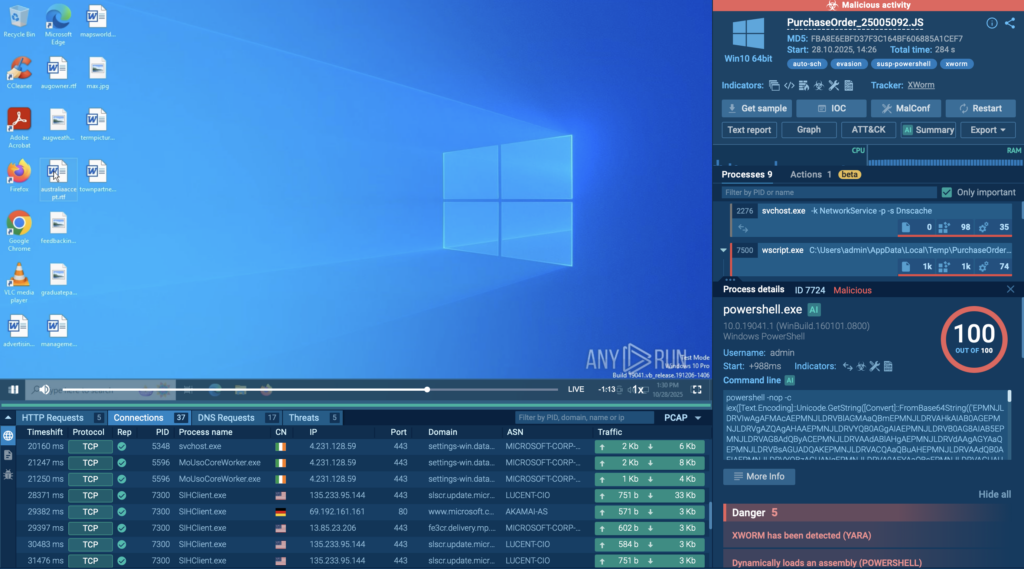
Below are ready-to-use TI Lookup queries for finding similar campaigns:
In November, ANY.RUN analysts identified JSGuLdr, a multi-stage loader that moves from JScript to PowerShell and ultimately deploys PhantomStealer. The chain relies on obfuscation, COM-based execution, cloud-hosted payloads, and in-memory loading, allowing the final payload to run with limited on-disk exposure.
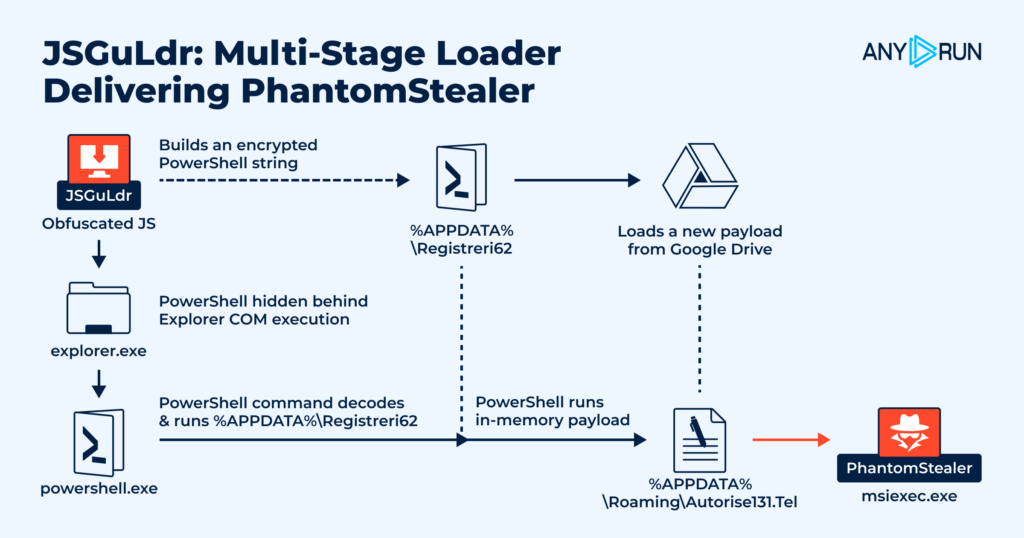
The first stage is an obfuscated JScript file signed with a fake Authenticode certificate to appear trustworthy (T1027, T1553.006). It generates an encrypted PowerShell string and writes it to %APPDATA%Registreri62, forming the second-stage component.
Execution then shifts to Shell.Application and Explorer COM interaction, which launches powershell.exe under explorer.exe, masking the activity as normal user behavior (T1559.001, T1218).
The PowerShell code decodes the contents of Registreri62, reconstructs hidden commands, and downloads an encrypted payload from Google Drive using a WebClient request (T1105). This payload is stored as %APPDATA%Autorise131.Tel, used as the on-disk container for the next stage (T1074.001).
PowerShell decrypts Autorise131.Tel, extracts raw bytes, and loads the resulting .NET assembly directly in memory (T1620). The final payload, PhantomStealer, is then injected into msiexec.exe, allowing it to run under a trusted Windows process and steal data without creating a conventional executable on disk (T1055, T1218.007).
Execution chain: wscript.exe → explorer.exe → explorer.exe (COM) → powershell.exe → msiexec.exe
Review the complete execution chain and behavioral indicators in the JSGuLdr analysis session.
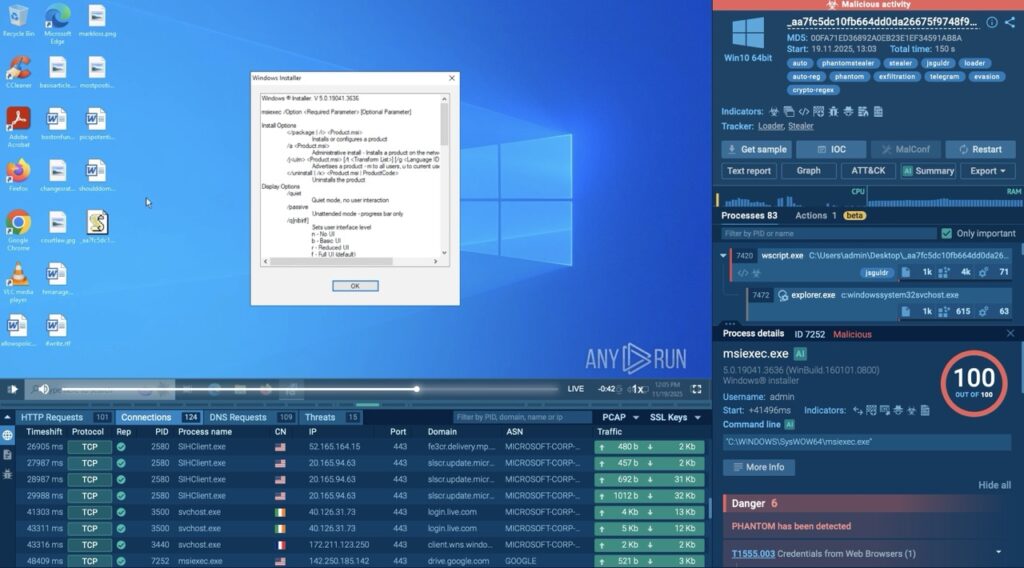
Use the following TI Lookup query to identify related JSGuLdr activity, pivot from shared IOCs, and uncover additional loader variants across recent submissions.
commandLine:”windowssystem32″ and imagePath:”explorer.exe”
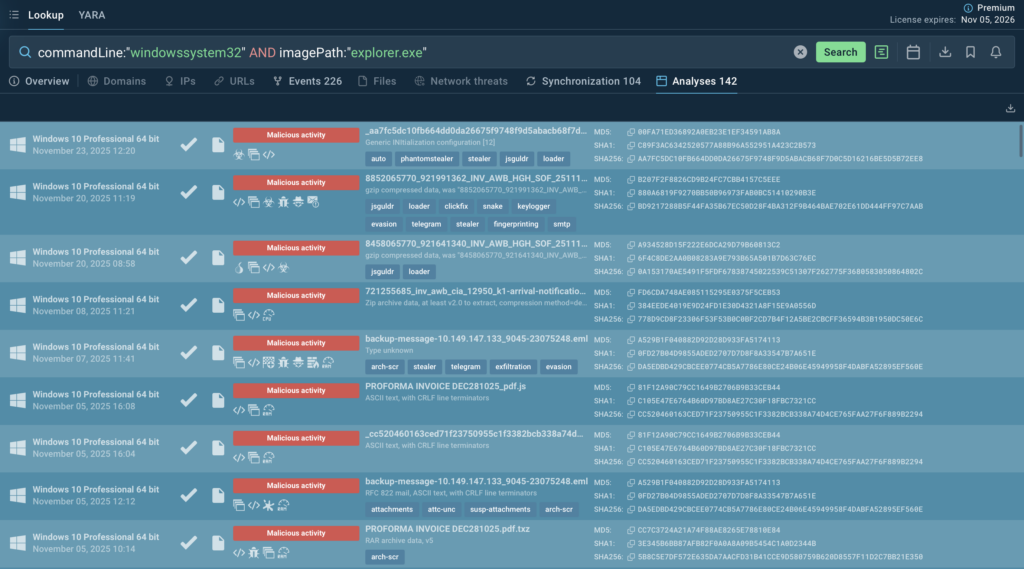
This Threat Brief provides a focused breakdown of three active threats, including how each sample behaves in the sandbox, its persistence and execution patterns, and the key detection points analysts can rely on. The report includes details about process activity, file system changes, network behavior, and extracted indicators, along with TI Lookup queries tailored to each malware family; PDFChampions’ mutex-based signature, Efimer’s Tor-based curl command, and BTMOB’s Android configuration file.
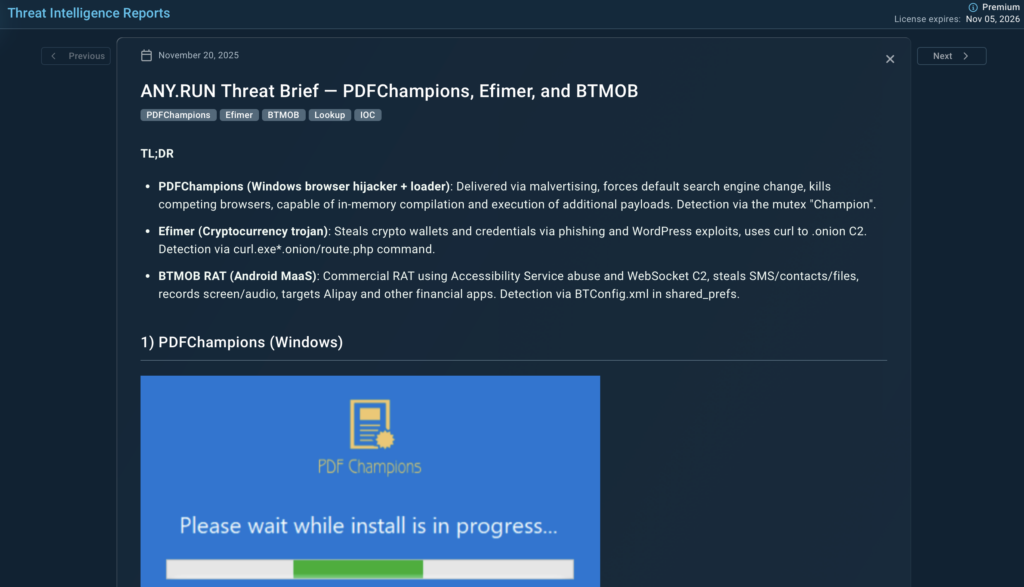
PDFChampions (Windows)
A browser hijacker distributed via malvertising that also acts as a loader. It changes the default search engine, terminates competing browsers, and can download and run additional payloads directly in memory.
Detection note: identify activity via the mutex “Champion.”
TI Lookup: syncObjectName:”Champion”
Efimer (Windows)
A cryptocurrency-focused trojan spread through phishing and compromised WordPress sites. It steals wallets and credentials and uses curl.exe to reach a Tor-hidden C2 endpoint (.onion/route.php).
Detection note: monitor curl connections to .onion/route.php.
TI Lookup: commandLine:”curl.exe*.onion/route.php”
BTMOB RAT (Android)
An Android RAT sold as MaaS. It abuses Accessibility Services for full device control, records screen and audio, and targets financial apps. Distributed through phishing APKs.
Detection note: presence of BTConfig.xml in the app’s shared preferences.
TI Lookup: filePath:”/data/data/*/shared_prefs/BTConfig.xml”
This month’s Threat Brief examines three threats in detail, with execution-flow screenshots, detection indicators, persistence artifacts, and public-sample telemetry. The report also provides ready-to-use TI Lookup queries and IOCs so teams can expand visibility and identify similar cases in their environments.
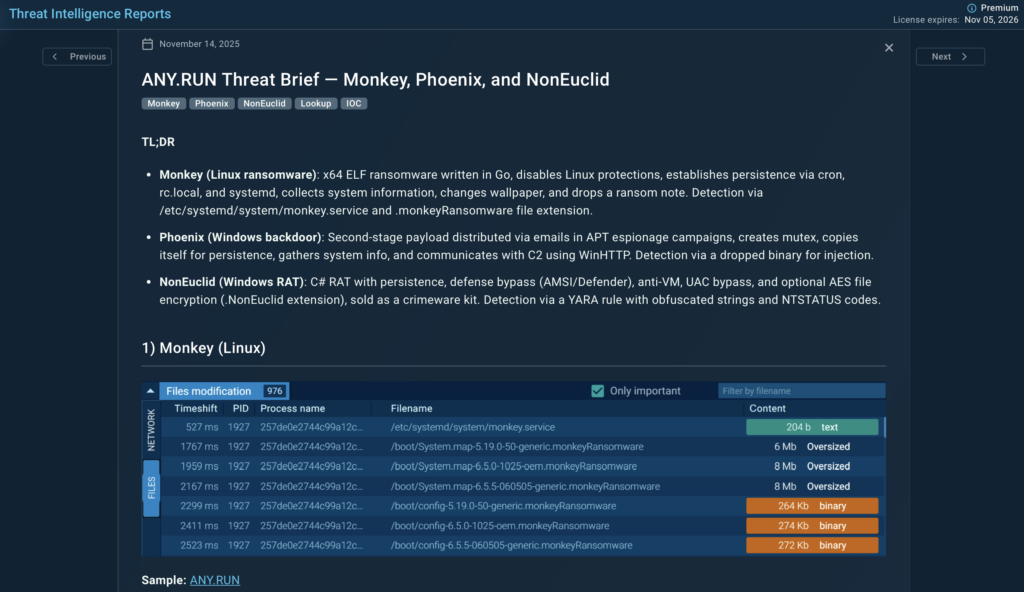
Monkey (Linux)
Monkey is a Go-based x64 ELF ransomware that disables security controls, establishes persistence through cron, rc.local, and systemd, collects system information, and encrypts files with a .monkeyRansomware extension. It also drops a ransom note and changes the system wallpaper.
Detection note: creation of /etc/systemd/system/monkey.service.
Lookup: filePath:”/etc/systemd/system/monkey.service”
Phoenix (Windows)
Phoenix is a Windows backdoor delivered as a second-stage payload in targeted email campaigns. It creates a mutex, copies itself for persistence, gathers system information, and communicates with its C2 via WinHTTP. The malware also uses process injection during execution.
Detection note: dropped binary sysProcUpdate.exe used for injection.
Lookup: registryValue:”sysProcUpdate.exe”
NonEuclid (Windows)
NonEuclid is a C# RAT with persistence, AMSI and Defender bypass, anti-VM checks, UAC bypass, and optional AES-based file encryption using the .NonEuclid extension. Sold as a crimeware kit, it combines remote control features with ransomware capabilities and uses obfuscated strings and NTSTATUS codes that can be detected via a dedicated YARA rule.
Detection note: YARA detection based on obfuscated Unicode strings and NTSTATUS markers.
This Threat Brief examines three Windows-based threats with different infection vectors and persistence patterns. The report includes sandbox screenshots, process activity, on-disk artifacts, and TI Lookup queries for tracking related behavior across public submissions.
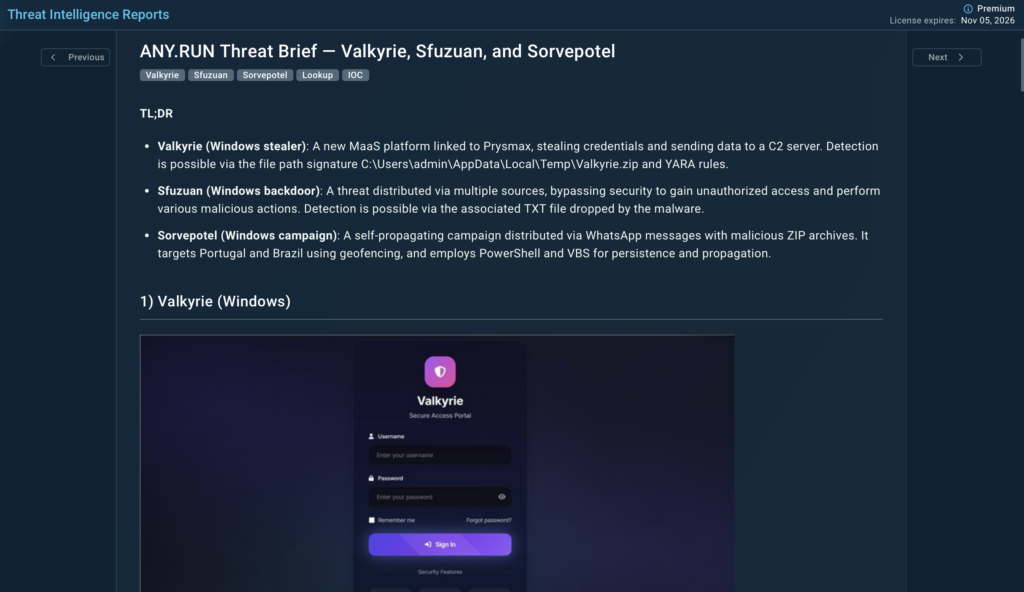
Valkyrie (Windows)
Valkyrie is a credential-stealing MaaS platform linked to Prysmax. It collects browser and system data, stores temporary output in Valkyrie.zip under the Temp directory, and exfiltrates the archive to a remote C2. Detection is possible through the Temp-path signature or a dedicated YARA rule included in the report.
TI Lookup: filePath:”C:\Users\admin\AppData\Local\Temp\Valkyrie.zip”
Sfuzuan (Windows)
Sfuzuan is a backdoor distributed through multiple, unrelated sources. It bypasses system protections to gain access, gathers system and location details, and connects to a set of rotating command-and-control domains. The malware drops a distinctive TXT file that serves as a reliable detection point.
TI Lookup: filePath:”C:\Windows\864ac8″
Sorvepotel (Windows)
Sorvepotel is a self-propagating campaign spread through WhatsApp messages containing malicious ZIP archives. After launch, it uses PowerShell and VBS scripts for execution and persistence, creates scheduled tasks, and automatically sends the same archive to all WhatsApp Web contacts. The campaign targets Portugal and Brazil using geofencing based on IP and system language.
TI Lookup: filePath:”Orcamento-2025*”
Multi-stage loaders, encrypted payload containers, and region-aware campaigns are getting harder to catch with static filtering alone. While these threats unfold across PowerShell chains, COM-triggered executions, Linux services, or Android components, attackers move quickly, and manual triage can’t keep up. ANY.RUNgives SOC teams the behavioral visibility they need to respond at the speed of modern attacks.
Here’s how teams stay ahead:
For SOC teams, MSSPs, and threat researchers, ANY.RUN provides the depth and real-time visibility needed to investigate faster, validate threats quickly, and turn emerging behaviors into reliable detection logic.
Explore ANY.RUN with a 14-day trial →
ANY.RUN supports more than 15,000 organizations worldwide across finance, healthcare, telecom, retail, and technology, helping security teams investigate threats with clarity and confidence.
Built for speed and deep visibility, the solution combines interactive malware analysis with live threat intelligence, allowing SOC analysts to observe real execution behavior, extract indicators, and understand attacker techniques in seconds.
By integrating ANY.RUN’s Threat Intelligence suite into existing security workflows, teams can accelerate investigations, reduce uncertainty during incidents, and strengthen resilience against fast-evolving malware families and multi-stage attack chains.
The post Major Cyber Attacks in November 2025: XWorm, JSGuLdr Loader, Phoenix Backdoor, Mobile Threats, and More appeared first on ANY.RUN’s Cybersecurity Blog.
ANY.RUN’s Cybersecurity Blog – Read More
Social media influencers can provide reach and trust for scams and malware distribution. Robust account protection is key to stopping the fraudsters.
WeLiveSecurity – Read More
Why your business needs the best-of-breed combination of technology and human expertise
WeLiveSecurity – Read More
Alert overload is one of the hardest ongoing challenges for a Tier 1 SOC analyst. Every day brings hundreds, sometimes thousands of alerts waiting to be triaged, categorized, and escalated. Many of them are false positives, duplicates, or low-value notifications that muddy the signal.
When the queue never stops growing, even experienced analysts start losing clarity, missing patterns, and risking oversight of critical threats.
Alert overload isn’t just unproductive — it’s toxic. Constant false positives create chronic stress, anxiety, and decision fatigue. Analysts doubt themselves, experience imposter syndrome, and burn out fast. Many leave the industry within years, citing mental health tolls like sleep loss and eroded confidence from missing “the big one” amid the chaos.
Tier 1 analysts who triage efficiently using context gain sharp investigation skills, earn trust for escalations, and accelerate to Tier 2/3 roles. They avoid burnout, stay passionate about cybersecurity, and position themselves as indispensable experts in a high-demand field. Solutions like ANY.RUN’s Threat Intelligence Lookup can provide a master key not only to an analyst’s career, but to the next level of SOC efficiency.
Alert overload at Tier 1 creates bottlenecks: unnecessary escalations flood senior analysts, response times balloon, and real breaches slip through. This drains budgets on prolonged incidents, erodes team morale, and weakens organizational defenses, turning a proactive SOC into a reactive firefighting unit.
Threat intelligence gives analysts the missing piece they often need during triage: context. Instead of manually searching for data across multiple sources, TI instantly tells you what the alert is truly about.
Was this domain seen in phishing attacks? Is this hash connected to a malware family? Is the mutex associated with known malicious samples?
With enriched data, Tier 1 analysts spend less time guessing and more time making confident decisions. Context transforms alerts from ambiguous into actionable and significantly reduces both cognitive load and triage time.
The key is having threat intelligence that’s immediately accessible during your investigation workflow, comprehensive enough to cover the indicators you encounter, and current enough to reflect the latest threat landscape. When used effectively, threat intelligence doesn’t just help you process alerts faster. It improves your accuracy, reduces the anxiety of uncertainty, and helps you develop the threat intuition that distinguishes experienced analysts.
ANY.RUN’s Threat Intelligence Lookup provides immediate, precise context from one of the largest ecosystems of analyst-generated data worldwide. It connects information from 15,000+ SOCs and security teams and presents it in a clean, friendly format.
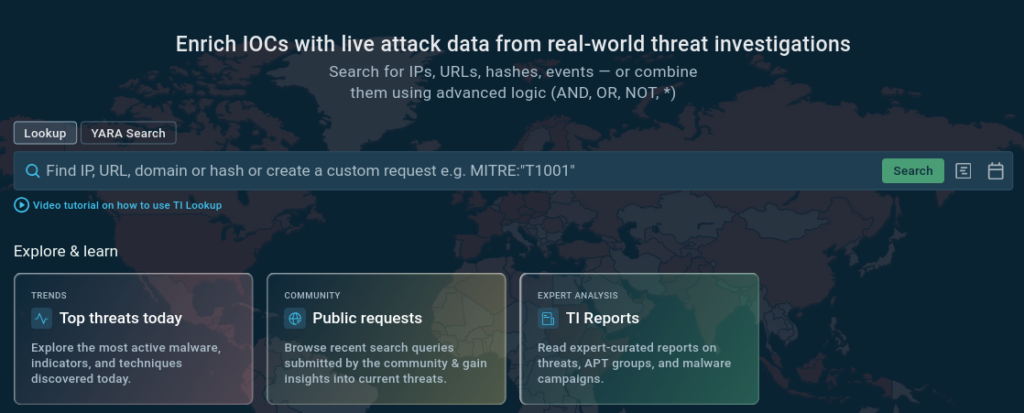
Instead of digging through scattered reports, teams get immediate answers: malware classification, sample behavior, network connections, relationships, and IOCs — all based on real sandbox runs.
This dramatically shortens triage time and reduces the chance of overlooking critical details hidden inside the noise.
An alert flags a weird domain in network traffic. Paste it into ANY.RUN TI Lookup: instantly reveal if it’s a known C2 server, tied to ransomware like LockBit, with resolved IPs, associated hashes, and full attack chains from recent sandbox runs. Result? Confident closure or escalation, saving hours and stopping lateral movement cold.
domainName:”edurestunningcrackyow.fun”
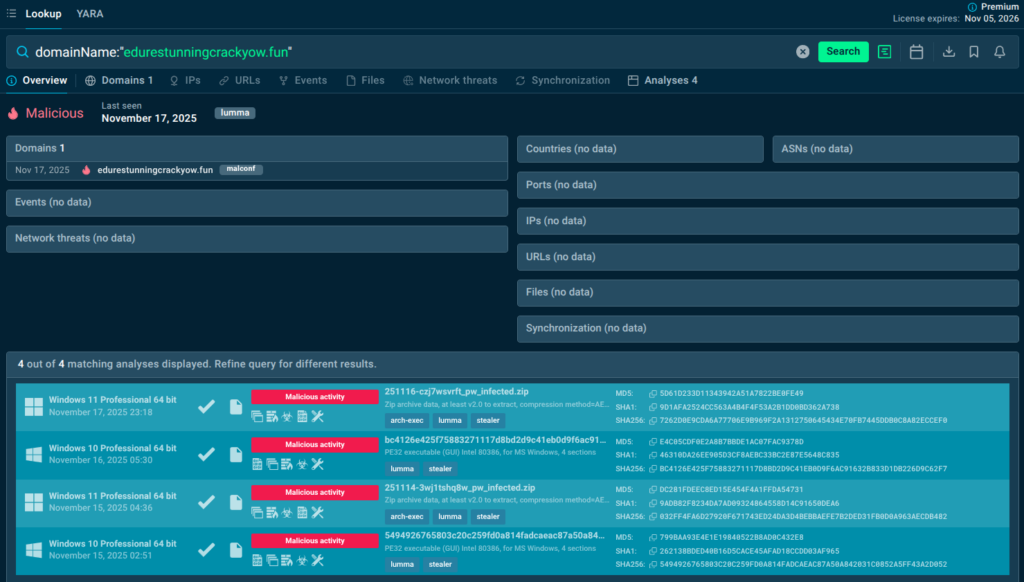
EDR alerts on a dropped executable hash. Query TI Lookup: uncover the exact malware family (e.g., RedLine stealer), prevalence stats, extraction TTPs, and behavioral details from detonations. Benefit: Precise containment (block similar hashes), updated detections, and proof for stakeholders: no deep dives needed.
md5:”dfe60536382cc0d30416bce4c85e6044″

A process creates an odd mutex (mutual exclusion object). Search it in TI Lookup’s synchronizations tab: link it to families like DCRat or AsyncRAT, view creating processes, and jump to sandbox sessions showing persistence tactics. Outcome: Rapid hunting across endpoints, stronger YARA rules, and blocking reinfection before damage spreads.
syncObjectName:”*sm0:4360:304:wilstaging_02″
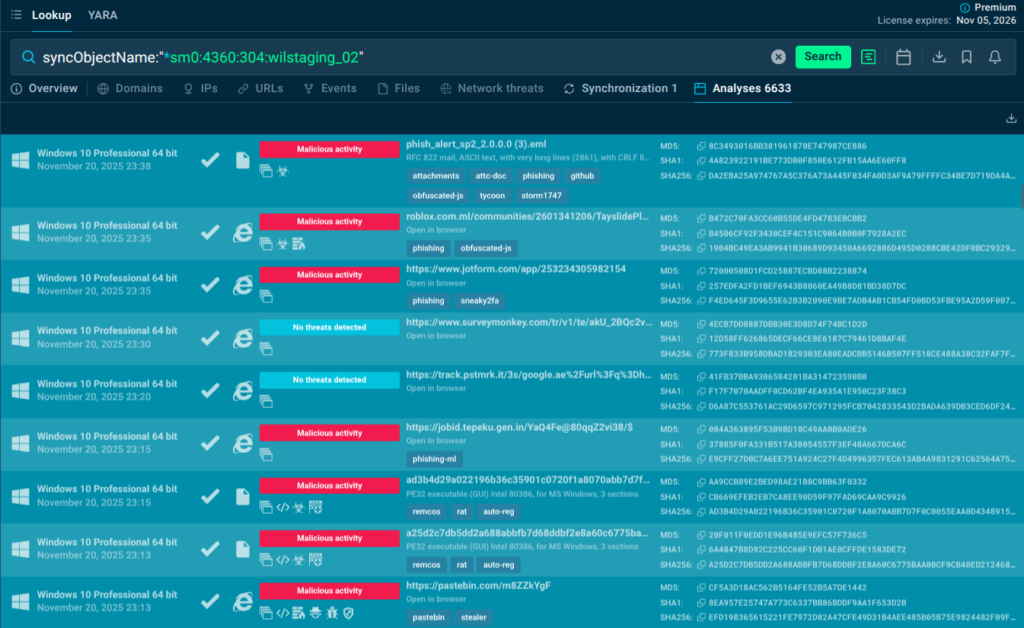
Alert overload is not an inevitable curse of SOC work, it’s a solvable problem that demands both systemic improvements and individual strategy.
The difference between analysts who burn out and those who thrive often comes down to their ability to extract context quickly, make confident decisions, and focus their limited time on high-value investigations. Threat intelligence platforms like ANY.RUN’s Threat Intelligence Lookup are not magic solutions that eliminate alerts, but they are force multipliers that transform your effectiveness by providing the context that turns ambiguous indicators into clear decisions.
By integrating threat intelligence into your daily workflow, you reduce investigation times from minutes to seconds, improve accuracy by relying on aggregated community knowledge, and build the pattern recognition skills that define senior analysts. The critical incidents hiding in your alert queue will only become visible when you clear away the noise efficiently enough to spot them.
Take control of your alerts before they control you, leverage the intelligence resources available to you, and remember that becoming a great analyst isn’t about handling every alert. It’s about handling the right alerts in the right way.
Tier 1 analysts are the first responders to every alert. High volume, repetitive tasks, and time pressure make it easy to overlook critical incidents and lead to burnout, stress, and reduced accuracy.
Overwhelmed analysts escalate incorrectly, miss key signals, and slow down triage. This cascades across the SOC, delaying incident response and weakening the organization’s security posture.
Threat intelligence adds immediate context to alerts, helping analysts understand whether an IOC is benign or malicious without manual research. This shortens triage time and reduces cognitive load.
TI Lookup provides fast, behavior-based context from millions of real sandbox runs. Analysts can check domains, hashes, IPs, and mutexes in seconds and see relationships, malware families, and activity patterns.
Yes. By revealing whether an indicator is tied to known malware, seen in threats before, or associated with clean activity, TI Lookup allows analysts to make confident classification decisions.
TI Lookup supports enrichment for domains, URLs, IP addresses, file hashes, mutexes, and many other IOCs, each supplemented by sandbox-based behavioral insights and real analyst data.
By reducing guesswork and manual searching, TI Lookup lowers stress, improves accuracy, and helps analysts manage workloads more sustainably — supporting long-term career growth instead of fatigue-driven turnover.
ANY.RUN is a leading provider of interactive malware analysis and threat intelligence solutions. Today, 15,000+ organizations worldwide use ANY.RUN to speed up investigations, strengthen detection pipelines, and give their teams a clearer view of what’s really happening on their endpoints.
SOC teams using ANY.RUN report measurable improvements, including:
Start your 14-day trial of ANY.RUN today →
The post How to See Critical Incidents in Alert Overload: A Guide for SOCs and MSSPs appeared first on ANY.RUN’s Cybersecurity Blog.
ANY.RUN’s Cybersecurity Blog – Read More